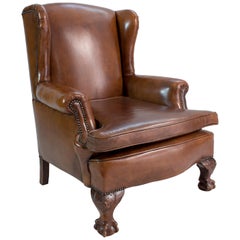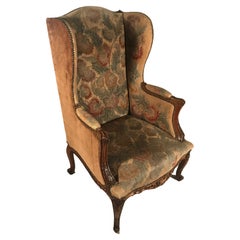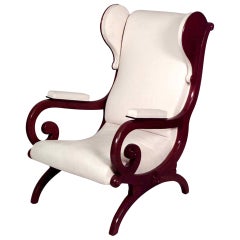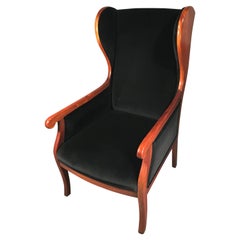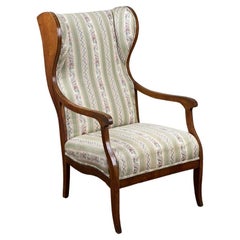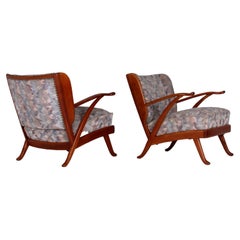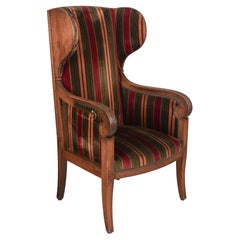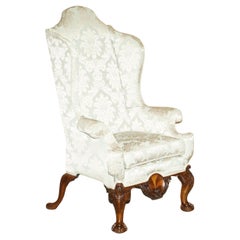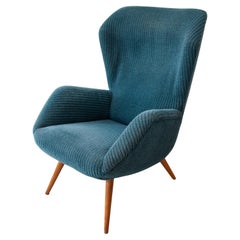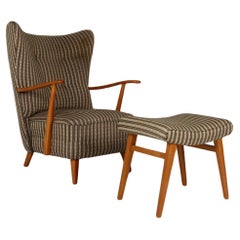German Wingback Chairs
to
3
3
3
6
Height
to
Width
to
Depth
to
5
1
1
1
1
1
3
2
1
1
1
1
6
3
2
2
1
39,028
538
162
159
156
6
6
6
Place of Origin: German
Art Deco Leather Wingback Armchair
Located in Darmstadt, DE
This Art Deco wingback armchair with an original frame of beechwood has been newly upholstered in hand-patinated sheep leather.
Very comfortable and extremely robust.
Measures: S...
Category
1920s Art Deco Vintage German Wingback Chairs
Materials
Beech, Leather
$4,192 Sale Price
23% Off
Baroque Wingback Armchair, Germany 18th century
Located in Leimen, DE
Introducing an exquisite Baroque wingback armchair that transports you back to the elegance of the 18th century. This remarkable piece, originating from Germany around 1760, showcase...
Category
1760s Baroque Antique German Wingback Chairs
Materials
Walnut
$3,018 Sale Price
30% Off
German Biedermeier Mahogany Wing Chair
By Karl Friedrich Schinkel
Located in Queens, NY
German Biedermeier (2nd qtr.,19th Cent) mahogany sleigh back wing chair with open scroll design arms with padded arm rests. (designed attr: to KARL FRIEDRICH SCHINKEL)
Category
19th Century Biedermeier Antique German Wingback Chairs
Materials
Mahogany, Upholstery
Biedermeier Wingback Armchair, South German, 1840
Located in Belmont, MA
This stunning Biedermeier wingback armchair, crafted in South Germany around 1860, is a timeless example of 19th-century design. Made from beautifully grained yew wood, the chair sho...
Category
1840s Biedermeier Antique German Wingback Chairs
Materials
Yew
$3,200 Sale Price
20% Off
Antique 19th Century Biedermeier Fruitwood Wing Back Chair Probably German
Located in Westfield, MA
This elegant wing back chair reflects the restrained beauty of the Biedermeier period, likely crafted in Germany or Austria in the mid to late 19th century. Made of warm, honey-toned...
Category
Mid-19th Century Biedermeier Antique German Wingback Chairs
Materials
Fruitwood
Midcentury set of 2 solid cherry wood wingback armchairs & sofa Karl Nothhelfer
Located in Landshut, BY
just beautiful
SET of Sofa & 2 Wingback Armchairs
by Prof. Karl Nothelfer - Designed in 1957
maker: Schörle & Gölz in Stuttgart - Bad Cannstatt
solid Cherry Wood
new upholstery and fabrics in 1998 according to last owner ( since then just in use for 2 years so upholstery is perfect ! )
Seatrests can be removed - and fixed by clips on belts
- high class -
measurements:
easy chair is 70cm wide ~ sofa is 178cm wide
both: seating height 40cm ~ seating depth: 57cm
condition - all firm and in very good condition - no damages
furniture have fully been accurately cleaned ::
- 3 steps: A: air pistol - B: industrial hoover - C: latest Kärcher "wash&hoover" technology
- woods have been polished several times
note: please ask for shipping quote by sending us your postcode/destination
Prof. Karl Nothelfer
* 14 June 1900 ~~ + 20 May 1980
Since the beginning of the 15th century, the Nothelfer family of carpenters has been continuously resident in the former
town of Überlingen without interruption. Every carpenter at that time mastered
all the possibilities of woodworking: so did the Nothelfer. They could carpenter,
even carve altars and figures, and set them in gold, silver and paint.
(churches in Owingen and Hödingen]. Some family members lived and worked
and worked in Hedingen or Hödingen,like today the jubilarian Karl Nothelfer (this in 1975).
His father, Karl Anton Nothelfer, as the eldest of seven siblings, was able to take over his father's carpentry business in Überlingen.
Karl Anton Nothelfer, the eldest of seven siblings, was unable to take over his father's carpentry business in Überlingen.
He instead moved to the industrial town of Singen with his young wife Rosalie, née Hanner, from the
from Hohenzollern in 1896 and moved to the former Poststraße and founded his own carpenter's workshop.
He had a highsense of quality and form and was already a member of the German Werkbund before 1914.
Karl Nothelfer and his three siblings grew up in such air.
After attending school and the secondary school in Singen, the young Karl learned the carpenter's trade in his father's workshop then moved on to the Badische Landes-Kunstschule in Karlsruhe,
where he studied architecture. At that time the well-known furniture professor also worked there
Fritz Spannagel, born in Freiburg in 1891, who settled in 1938 at Ittendorf Castle near Meers-
burg (died 1957). In 1928, the gifted young architect received a teaching assignment at the
at the Karlsruhe School of Art, but followed his teacher Spannagel to Berlin in the same year.
Berlin. Here he worked from 1928-1945 as a teacher - appointed professor in 1931 - at the
Berlin Tischler-Schule, the later Bauschule für Raumgestaltung.
The furniture he created in Berlin became internationally known through many exhibitions and lectures.
nationally known and influential. His furniture creations ushered in a new era in German and
a new era in German and European furniture design. At the world exhibition in Paris
1937 Prof. Nothelfer was awarded the Golden Medal for his work in the furniture sector.
for his work in the furniture sector. A first summary and balance of his work on furniture is given in his standard work
1942 published standard work "Das Sitzmöbel", the first compendium of its kind in the world.
world. In 1950 he published his second work "Furniture". Both books and a
series of brochures were published by Verlag Otto Maier, Ravensburg.
Karl Nothelfer continued to work intensively on the design of seating furniture in the years after 1945.
In 1950 he succeeded in the important invention of the two-legged skid-base chair, which has been
orthopedically - anatomically tested thousands of times - has become accepted all over the world today.
Even the most distinguished American furniture companies such as Miller or Knoll-International
use the skid as the main theme for desks and chairs. At the same time, N. had a groundbreaking
in the redesign of German school furniture and seating for industry.
industry. He succeeded in adapting his furniture forms, which originated in wood and handicraft, to the modern technical
modern technical possibilities of the industry. He thus became the great refor-
of schoolroom furnishings. The architect Nothelfer thinks about himself,
that he made his main contribution in the field of seating furniture, although this was not
was not really his profession.
After the war, Prof. Nothelfer, like so many others, had to start all over again. He settled
settled in his home town of Lake Constance in Hödingen in 1945 as a freelance architect and was
and was involved in all areas of construction in the years after the war. As early as 1935, he had given many
the example of American prefabricated buildings and recommended serial house
and recommended it at a time when no one in Germany was even thinking about mass production. Now he developed
he developed several types of mass-produced houses, which were manufactured in Baiersbronn.
of which more than 800 houses were built in France alone (types Paris, Provence, Normandie).
were built. At that time [1946], as part of the reparations in Strasbourg, there was an exhibition of houses with Swedish, Danish, and French designs.
with Swedish, Danish, Finnish, English and German houses, where the French occupation
for which 6 different types were sent from the French occupation zone, the
Nothelfer's house type was considered the top of this exhibition.
Karl Nothelfer was also involved in the development of chipboard. In 1946, together with others in Munich, he founded the first
magazine "Bauen und Wohnen" ("Building and Living") after the war and remained its co-editor for many years.
co-editor of this magazine for many years. By presenting his own work, he has here
interpreted what the essence of the magazine wanted to be: Building, in order to live in it, in order to live as a human being and humanly in the built. Karl Nothelfer planned his houses
furniture ground plan, from the need for living. In 1948 he was appointed honorary senator of the State Building
school in Holzminden.
Karl Nothelfer did not build much in Singen. The first post-war house was Haus
Fahr on the slope of the Hohentwiel (Domäne); the building material came from a demolished
log house that a French officer had built for himself on the Schie- nerberg.
nerberg. In 1952, he also built the administration building of the aluminum rolling mill in Singen.
rolling mills in Singen, with relief and wall painting by C. G. Becker. In Überlingen he built
In Überlingen he built, among others, the Buchinger Sanatorium, the Riese+ Hähnel radio house and
various reconstructions in the old town: Haus Kitt with the Glockenspiel, the Haus mit dem
Bacchus in the Überlingen village, the Dolphin Fountain in Hödingen (1975). Probably the most beautiful
Haus Nothelfers, the Haus Himmelheber, stands in Baiersbronn-Tonbach. On the airfield
Mengen, Nothhelfer built the casino building with the 30 square meter faience painting Ikarus by
C. G. Becker. In 1954 he founded a second office with architect Hans Schwingen in Düsseldorf.
Office, which primarily fertilized the housing construction, true to the motto:from the inside to
planning from the outside. The Minister of Housing awarded a prize to the best social housing in North Rhine-
Westphalia; it was from the Nothelfer+Schwingen studio in Düsseldorf. Also the idea of
new idea of home ownership was also promoted by Nothelfer+Schwingen.
promoted by Nothelfer+Schwingen. On the occasion of the red jubilee of the law about condominium ownership
Nothelfer gave a lecture in Essen in 1961 on condominium ownership in Europe (published as a brochure).
published as a brochure]. From Düsseldorf, among many others, in the silk city...
Category
1950s Mid-Century Modern Vintage German Wingback Chairs
Materials
Fabric, Cherry, Upholstery
Related Items
19th Century French Reclining Wing Chair
Located in Winter Park, FL
A 19th century French Louis Philippe style upholstered reclining wing chair. A brass ring pull latch and sawtooth mechansim on the sides of the arms adjusts the slant of the back. So...
Category
19th Century Louis Philippe Antique German Wingback Chairs
Materials
Brass
Antique 1840 Museum Quality Claw & Ball Carved Feet Wingback Very Large Armchair
Located in West Sussex, Pulborough
We are delighted to offer for sale this absolutely sublime, museum quality extra large Wingback armchair with ornately carved Claw & Ball legs
What a chair, you will never see ano...
Category
1840s Early Victorian Antique German Wingback Chairs
Materials
Upholstery, Hardwood
$9,634
H 53.94 in W 30.12 in D 32.29 in
Antique German Biedermeier Mahogany Fauteuil Wingback Library Arm Chair
Located in Dayton, OH
Antique mid to early 19th century German Biedermeier library / lounge armchair. Made of mahogany featuring traditional form with fauteuil padded arms and flared ear / wing back with...
Category
Early 19th Century Biedermeier Antique German Wingback Chairs
Materials
Upholstery, Mahogany
$1,880 Sale Price
20% Off
H 45 in W 34 in D 28 in
Fully Restored Vintage Chesterfield Porters Wingback Armchair Brown Leather
By Chesterfield
Located in West Sussex, Pulborough
We are delighted to offer for sale this stunning vintage Porters barrel back armchair in whisky brown leather
This chair a real tour de force, is has absolutely everything going ...
Category
20th Century Chesterfield German Wingback Chairs
Materials
Leather
$5,193
H 42.13 in W 30.71 in D 30.71 in
Pair of Vintage Black Velvet Upholstered George Hepplewhite Wingback Armchairs
By George Hepplewhite
Located in West Sussex, Pulborough
We are delighted to offer for sale absolutely stunning pair of vintage oversized George Hepplewhite wingback armchairs with the Philadelphia oversized wings
These are a showstoppi...
Category
20th Century Art Deco German Wingback Chairs
Materials
Velvet, Beech
$7,226 Sale Price / set
25% Off
H 48.43 in W 33.47 in D 33.86 in
Upholstered Barley Twist Wing Back Lounge Chairs
Located in Southampton, NJ
A pair of early 20th C. English Barley twist wing back chairs with original finish, new custom upholstery, loose cushions on the seats & H stretchers. Striking mid size silhouettes; ...
Category
Early 20th Century William and Mary German Wingback Chairs
Materials
Upholstery, Oak
19th Century Georgian Black Leather-Upholstered Wingback Armchair
Located in London, GB
A Georgian black leather-upholstered wingback armchair outlined with a close nail trim and raised on cabriole legs terminating in scrolled feet.
Category
Late 19th Century Georgian Antique German Wingback Chairs
Materials
Leather, Wood
$3,234
H 43.31 in W 32.68 in D 28.35 in
Early 20th C English Button Tufted Leather Wing Back Library Chair
Located in Troy, MI
Found in England, this leather wing back library chair dates from the 1910 - 1920s. Tall seat back, wings and seat are upholstered in original button-tufted leather with brass nail h...
Category
Early 20th Century Chippendale German Wingback Chairs
Materials
Brass
Pair of Antique Upholstered Wingback Armchairs
Located in Los Angeles, CA
1920s Upholstered Wing Back Armchair on walnut cabriole legs.
Beautiful fabric. Tassels hanging at the bottom from the chair.
Category
19th Century George III Antique German Wingback Chairs
Materials
Fabric
ANTIQUE FULLY RESTORED BORDEAUX LEATHER TUFTED CHESTERFIELD WiNGBACK ARMCHAIR
By Chesterfield
Located in West Sussex, Pulborough
Royal House Antiques
Royal House Antiques is delighted to offer for sale this stunning fully restored vintage Chesterfield tufted Bordeaux leather wingback armchair
Please note the...
Category
1920s Regency Vintage German Wingback Chairs
Materials
Leather
$3,922
H 46.46 in W 33.47 in D 32.68 in
Otto Schulz 1940s Sheepskin Swedish Wing Chair
By Otto Schulz
Located in London, England
Otto Schulz Wing chair, c1940s
An imposing and impressive wing chair from Swedish master designer Otto Schulz, produced by hiss own company Boet in Gothenburg Sweden in the 1940s....
Category
1930s Scandinavian Modern Vintage German Wingback Chairs
Materials
Sheepskin, Elm
Stunning Kilim Wool Upholstered Wingback Armchair Beech Frame Diamond Pattern
Located in West Sussex, Pulborough
We are delighted to offer for sale this stunning Kilim upholstered wingback armchair in perfect condition throughout
A well made and decorative armchair which is very comfortable...
Category
20th Century Mid-Century Modern German Wingback Chairs
Materials
Upholstery, Wood
$1,926 Sale Price
30% Off
H 46.46 in W 31.5 in D 29.93 in
Previously Available Items
High Wingback Lounge Chair, Germany designed by Ernst Jahn, 1950s
By Ernst Max Jahn, Deutsche Werkstätten Hellerau
Located in Antwerp, BE
A wingback lounge chair designed by German designer Ernst Max Jahn for Deutsche Werkstätten Hellerau. The frame has a beautiful, design, stands on four elegant tapering teak legs and...
Category
1950s Mid-Century Modern Vintage German Wingback Chairs
Materials
Upholstery, Wood
1950s wing back arm chair & ottoman extremely comfy solid make beech exc condit
Located in Landshut, BY
extremely comfortable
Western German
1950s
wing back arm chair + footstool
in very good A++ condition
solid beech high class firm spring upholstery
please feel free to ask for a ...
Category
1950s Mid-Century Modern Vintage German Wingback Chairs
Materials
Fabric, Beech
H 40.56 in W 28.75 in D 27.56 in
German Art Deco Wingback Chair in Gray Boucle Fabric, 1925
Located in Berlin, DE
This great wingback chair from the 1920s has been completely reupholstered and covered with a high quality gray boucle fabric.
The armchair is very comfortable and a great highlight...
Category
1920s Art Deco Vintage German Wingback Chairs
Materials
Bouclé, Hardwood
Vintage Ergonomic Harry Bertoia Lounge Bird Chair for Knoll
By Knoll, Harry Bertoia
Located in Antwerp, BE
Original Vintage Harry Bertoia Bird chair for Knoll 1960s with an original Knoll fabric flame red slip cover on a metal white and black coated frame.The High Wingback chair is in ori...
Category
1960s Mid-Century Modern Vintage German Wingback Chairs
Materials
Metal, Wire
Reclining Baroque Wingback Chair, Germany 18th Century, Walnut
Located in Belmont, MA
Reclining Baroque wingback chair, Southern Germany 1750-1760, walnut. This rare and interesting armchair is in original condition. The 18th century recline...
Category
1750s Baroque Antique German Wingback Chairs
Materials
Walnut
Biedermeier Wing Chair, Adjustable, Walnut, South Germany, circa 1820
Located in Regensburg, DE
Wonderful so called 'Wing Chair' (German: "Ohrenbackensessel") from early Biedermeier time around 1820.
Walnut solid wood, hand polished with shellac (French polish).
Backrest is a...
Category
1820s Biedermeier Antique German Wingback Chairs
Materials
Brass
H 43.31 in W 24.81 in D 31.5 in
Madame Chair by Fritz Neth for Correcta, Germany, 1950s
By Correcta, Fritz Neth
Located in Pijnacker, Zuid-Holland
Rare and early model ‘Madame’ lounge chair by Fritz Neth for Correcta, Germany, 1950s. The chair is covered in a black (or very dark brown) pluche ...
Category
1950s Mid-Century Modern Vintage German Wingback Chairs
German Neoclassic Fruitwood & Upholstered Bergère Second Quarter of 19th Century
Located in Atlanta, GA
Of large proportion and having a concave backrest and enclosed arms, the upper portion of the arms with upholstered pads, all of the velvet upholstered areas trimmed in brass nailhea...
Category
1830s Neoclassical Antique German Wingback Chairs
H 41.5 in W 27.25 in D 34 in
Biedermeier Wingback Chair, 19th Century
Located in Greding, DE
Large wingback armchair on slightly tapered feet. The chair is made from walnut and is newly upholstered with a high quality fabric.
Category
19th Century Biedermeier Antique German Wingback Chairs
Materials
Fabric, Walnut
Antique Biedermeier Reclining Wingback Chair
Located in New York, NY
Antique, Biedermeier reclining wingback chair with a walnut frame. Has a down cushioned seat and casters. Reclining, iron, mechanism is in working...
Category
1850s Biedermeier Antique German Wingback Chairs
Materials
Iron
Bavarian Wingback Chair
Located in Round Top, TX
Bavarian wingback chair with a quarter sawn wood frame, soft leather upholstery and patinated brass nailhead trim, circa 1830.
Category
Mid-19th Century Antique German Wingback Chairs
Materials
Leather, Wood
Fantastic pair of Armchairs, Biedermeier, 19th Century
Located in Greding, DE
Fantastic pair of Wingback Chairs , Biedermeier, 19th Century.
Walnut veneer.
The upholstery is striped silver/dark anthracite.
Category
Mid-19th Century Antique German Wingback Chairs
Materials
Walnut
Read More
Arne Jacobsen’s Egg Chair Scrambled the Idea of What a Wingback Could Be
The curvaceous Egg was designed to cradle the body and offer privacy. Later, it became the seat of choice for bosses in movies, too.
23 Ways to Rethink the Classic Wingback Chair
We take a fresh look at a more than 300-year-old fixture in furniture design.
Recently Viewed
View AllMore Ways To Browse
Teak Buddha
Three Legged Vessel
Three Tier Serving Trays
Tibet Earring
Tiffany And Co China
Tiffany Blue Rims
Tiffany Sterling Ice Tea Spoons
Torchiere Sculpture
Towle Contour Sterling Silver
Trifold Mirror
Used Blueprint Storage Drawers
Used Grain Storage Bins
Vallauris Fat Lava
Vargueno Cabinet
Venetian Bombe Chest
Venetian Glass Figurines
Venezia Vintage Poster
Vermont Pottery
